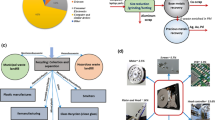Abstract
This study aimed to characterize a polymer waste, originating from polyorganosiloxane polymerization processes, prior its end-of-life treatment in order to identify and quantify the possibly contained nano-fillers. The polymer waste was first characterized in terms of its physical–chemical properties by combining different approaches and analytic techniques such as standard ultimate and elemental analysis or techniques like infrared spectroscopy or thermogravimetric analysis coupled with gas chromatography and mass spectroscopy to define the polymer waste molecular structure. The second step was devoted to identify and characterize the nano-fillers contained in the polymer waste, if any, in terms of particle size distribution, morphology and composition. Due to the thermal degradability of the polymer waste above 50 °C, the cryo-ultramicrotomy and the transmission electron microscopy techniques were used. Polydimethylsiloxane was identified as the core polymer unit, and the presence of the suspected SiO2 nano-fillers was confirmed, with three different morphologies detected: elongated and hexagonal, both found in the particle size range of 100–500 nm in diameter; and spherical, present in the population of particles ≤100 nm in diameter. In particular, a relatively large amount of K (2.81 wt%) was also identified in the waste. The mass content of SiO2 nano-fillers in the polymer waste was estimated to 24.4 wt%.





Similar content being viewed by others
References
Vance, M.E., Kuiken, T., Vejerano, E.P., McGinnis, S.P., Hochella Jr., M.F., Rejeski, D., Hull, M.S.: Nanotechnology in the real world: redeveloping the nanomaterial consumer products inventory. Beilstein J. Nanotechnol. 6, 1769–1780 (2015)
Roco, M.C., Mirkin, C.A., Hersam, M.C.: Nanotechnology research directions for societal needs in 2020: summary of international study. J. Nanopart. Res. 13, 897–919 (2011)
Borm, P.J.-A., Robbins, D., Haubold, S., Kuhlbusch, T., Fissan, H., Donaldson, K., Schins, R., Stone, V., Kreyling, W., Lademann, J., Krutmann, J., Warheit, D., Oberdorster, E.: The potential risks of nanomaterials: a review carried out for ECETOC. Part. Fibre Toxicol. 3, 11 (2006)
Som, C., Wick, P., Krug, H., Nowack, B.: Environmental and health effects of nanomaterials in nanotextiles and façade coatings. Environ. Int. 37, 1131–1142 (2011)
Bondarenko, O., Juganson, K., Ivask, A., Kasemets, K., Mortimer, M., Kahru, A.: Toxicity of Ag, CuO and ZnO nanoparticles to selected environmentally relevant test organisms and mammalian cells in vitro: a critical review. Arch. Toxicol. 87, 1181–1200 (2013)
Fratoddi, I., Venditti, I., Cametti, C., Russo, M.V.: How toxic are gold nanoparticles? the state-of-the-art. Nano Res. doi:10.1007/s12274-014-0697-3 (2014)
OECD: Nanomaterials in Waste Streams: Current Knowledge on Risks and Impacts, OECD Publishing, Paris. doi:10.1787/9789264249752-en (2016)
Piccinno, F., Gottschalk, F., Seeger, S., Nowack, B.: Industrial production quantities and uses of ten engineered nanomaterials in Europe and the world. J. Nanopart. Res. 14(9), 1–11 (2012)
Griepink, B., Wilkinson, H.C., Scholz, A.: The certification of the ash content and of the gross calorific value of three coals. Report, EUR 11000 (1987)
Hamdani, S., Longuet, C., Perrin, D., Lopez-Cuesta, J.M., Ganachaud, F.: Flame retardancy of silicone-based materials. Polym. Degrad. Stab. 94, 465–495 (2009)
Huang, W., Yibei, F., Chaoyang, W., Yunshu, X., Zhishang, B.: A study on radiation resistance of siloxane foam containing phenyl. Radiat. Phys. Chem. 64, 229–233 (2002)
Kim, D.S., Park, H.B., Rhim, J.W., Lee, Y.M.: Preparation and characterization of crosslinked PVA/SiO2 hybrid membranes containing sulfonic acid groups for direct methanol fuel cell applications. J. Membr. Sci. 240, 37–48 (2004)
Labouriau, A., Cox, J.D., Schoonover, J.R., Patterson, B.M., Havrilla, G.J., Stephens, T., Taylor, D.: Mössbauer, NMR and ATR-FTIR spectroscopic investigation of degradation in RTV siloxane foams. Polym. Degrad. Stab. 92, 414–424 (2007)
Kim, S., Lee, C.-Y.: Jin, M.H-C.: Fourier-transform infrared spectroscopic studies of pristine polysilanes as precursor molecules for the solution deposition of amorphous silicon thin-films. Sol. Energy Mater. Sol. Cells 100, 61–64 (2012)
Ahangaran, F., Hassanzadeh, A., Nouri, S.: Surface modification of Fe3O4@SiO2 microsphere by silane coupling agent. Int. Nano Lett. 3, 23 (2013)
Launer, P.J.: Infrared analysis of organosilicon compounds: spectra-structure correlations. In: Anderson, R., Arkles, B., Larson, G.L. (eds.) Silicon Compounds: Register and Review, 4th edn, pp. 100–103. Petrarch Systems, Bristol, PA (1987)
Deka, B.K., Maji, T.K.: Effect of SiO2 and nanoclay on the properties of wood. Polym. Bull. 70, 403–417 (2012)
Camino, G., Lomakin, S.M., Lazzari, M.: Thermal polydimethylsiloxane degradation. Part 2. The degradation mechanisms. Polymer 43, 2011–2015 (2002)
Camino, G., Lomakin, S.M., Lazzari, M.: Polydimethylsiloxane thermal degradation Part 1. Kinetic aspects. Polymer 42, 2395–2402 (2001)
Cendrowski, K., Chen, X., Zielinska, B., Kalenczuk, R.J., Rümmeli, M.H., Büchner, B., Klingeler, R., Borowiak-Pale, E.: Synthesis, characterization, and photocatalytic properties of core/shell mesoporous silica nanospheres supporting nanocrystalline titania. J. Nanopart. Res. 13, 5899–5908 (2011)
Schnyder, B., Lippert, T., Kötz, R., Wokaun, A., Graubner, V.M.: Nuyken, O: UV-irradiation induced modification of PDMS films investigated by XPS and spectroscopic ellipsometry. Surf. Sci. 532, 1067–1071 (2003)
ASTM C1463-00, Standard Practices for Dissolving Glass Containing Radioactive and Mixed Waste for Chemical and Radiochemical Analysis, ASTM International, West Conshohocken, www.astm.org (2007)
Acknowledgements
This project, entitled NanoFlueGas, was financially supported by the French Agency for Environment and Energy Management (ADEME) through its CORTEA funding scheme (Grant No. 1181C0088). The authors would like to thank the IMN Laboratory for microscopic analysis.
Author information
Authors and Affiliations
Corresponding author
Rights and permissions
About this article
Cite this article
Tran, D.T., Joubert, A., Venditti, D. et al. Characterization of Polymer Waste Containing Nano-fillers Prior its End-of-Life Treatment. Waste Biomass Valor 8, 2463–2471 (2017). https://doi.org/10.1007/s12649-016-9757-0
Received:
Accepted:
Published:
Issue Date:
DOI: https://doi.org/10.1007/s12649-016-9757-0




